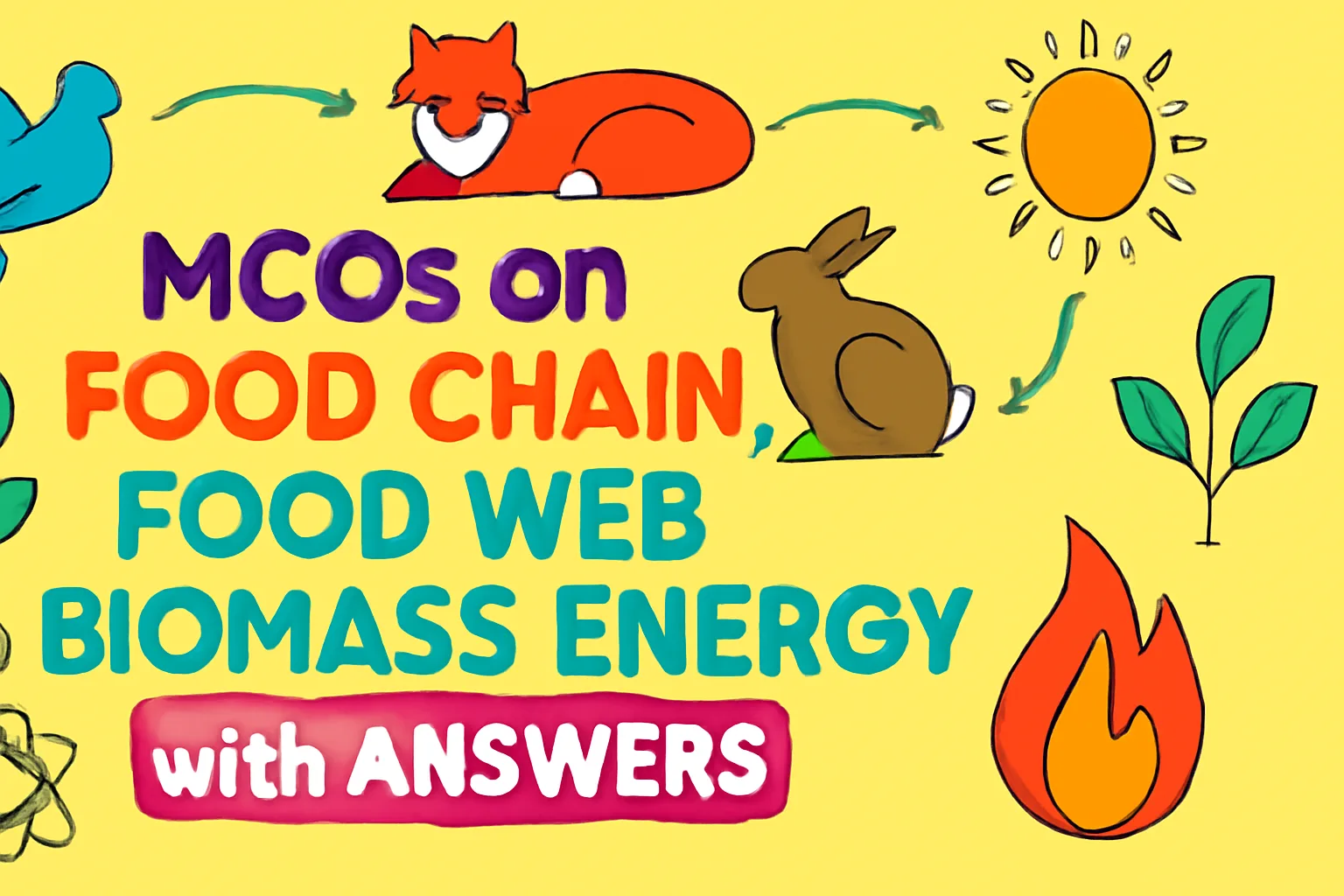Prepare for competitive exams with our MCQs on Food Chain, Food Web, and Biomass Energy Quiz (August 2025 Edition). These questions are highly researched and are very helpful for all upcoming exams that include JKSSB and SSC. After solving these questions, you can easily check your preparation level.MCQs help to assess knowledge and improve exam efficiency. MCQs also build test-taking skills, time management, and help identify strengths and weaknesses for targeted study and better performance for Exams.
Food Chain, Food Web & Biomass Energy MCQs
1. What is the term for the flow of nutrients and energy through different trophic levels?
(A) Food web
(B) Food chain
(C) Biomass
(D) Ecosystem
Answer: (B) Food chain
2. Which of the following organism groups produces its own food in the food chain?
(A) Consumers
(B) Decomposers
(C) Producers
(D) Carnivores
Answer: (C) Producers
3. Which trophic level do herbivores belong to in a food chain?
(A) Primary consumers
(B) Secondary consumers
(C) Tertiary consumers
(D) Producers
Answer: (A) Primary consumers
4. What is the primary source of energy for all living organisms in the ecosystem where we live?
(A) Water
(B) Sun
(C) Soil
(D) Air
Answer: (B) Sun
5. Which of the following organisms feed on primary consumers in a food chain for survival?
(A) Producers
(B) Decomposers
(C) Secondary consumers
(D) Herbivores
Answer: (C) Secondary consumers
6. What do decomposers convert dead organic matter into?
(A) Energy
(B) Inorganic nutrients
(C) Oxygen
(D) Water
Answer: (B) Inorganic nutrients
7. Which of the following belongs to the tertiary consumer?
(A) Deer
(B) Frog
(C) Lion
(D) Grasshopper
Answer: (C) Lion
8. What type of food chain begins with dead organic matter as the base?
(A) Grazing food chain
(B) Detritus food chain
(C) Aquatic food chain
(D) Terrestrial food chain
Answer: (B) Detritus food chain
9. In a forest food chain, which animal acts as the primary consumer in the trophic level?
(A) Grass
(B) Deer
(C) Lion
(D) Hawk
Answer: (B) Deer
10. Which pyramid type shows the number of organisms at each trophic level?
(A) Pyramid of energy
(B) Pyramid of biomass
(C) Pyramid of numbers
(D) Food web
Answer: (C) Pyramid of numbers
11. What is the main reason the number of trophic levels in a food chain is limited?
(A) Lack of sunlight
(B) 10 percent energy transfer rule
(C) Excess water
(D) Too many producers
Answer: (B) 10 percent energy transfer rule
12. What is biomagnification in an ecosystem?
(A) Decomposition of organic waste
(B) Accumulation of toxins at higher trophic levels
(C) Energy transfer from producers to consumers
(D) Growth of plants in sunlight
Answer: (B) Accumulation of toxins at higher trophic levels
13. Which of the following organisms are considered detritivores?
(A) Lions and tigers
(B) Millipedes and dung flies
(C) Frogs and snakes
(D) Phytoplankton and algae
Answer: (B) Millipedes and dung flies
14. What does a food web represent in an ecosystem?
(A) A linear food chain
(B) Interconnected food chains
(C) Only producers
(D) Only carnivores
Answer: (B) Interconnected food chains
15. Which process is NOT used for thermal conversion of biomass?
(A) Combustion
(B) Gasification
(C) Pyrolysis
(D) Fermentation
Answer: (D) Fermentation
16. What is biogas primarily composed of, which is produced by bacteria from organic waste?
(A) Carbon dioxide
(B) Methane
(C) Oxygen
(D) Nitrogen
Answer: (B) Methane
17. What role do humans play in resource production and consumption?
(A) Only producers
(B) Only consumers
(C) Both producers and consumers
(D) Neither producers nor consumers
Answer: (C) Both producers and consumers
18. Which pyramid type often shows an inverted shape in aquatic ecosystems?
(A) Pyramid of energy
(B) Pyramid of biomass
(C) Pyramid of numbers
(D) Pyramid of nutrients
Answer: (B) Pyramid of biomass
19. What happens to energy as it moves from one trophic level to the next?
(A) Increases by 10%
(B) Remains the same
(C) Decreases by 90%
(D) Doubles every time
Answer: (C) Decreases by 90%
20. Which of the following is an example of a primary producer in an aquatic ecosystem?
(A) Zooplankton
(B) Phytoplankton
(C) Small fish
(D) Algae-eating fish
Answer: (B) Phytoplankton
21. What does bioaccumulation mean in a food chain?
(A) Building up of toxic substances in individual organisms
(B) Transfer of energy between trophic levels
(C) Decomposition of organic matter
(D) Growth of biomass
Answer: (A) Building up of toxic substances in individual organisms
22. Which living organism forms the base of the food chain in a pond ecosystem?
(A) Algae
(B) Fish
(C) Snakes
(D) Birds
Answer: (A) Algae
23. What is the function of decomposers in the ecosystem?
(A) Produce food through photosynthesis
(B) Consume living animals
(C) Break down dead material and recycle nutrients
(D) Consume plants only
Answer: (C) Break down dead material and recycle nutrients
24. Which type of biomass is produced without human intervention?
(A) Residual biomass
(B) Natural biomass
(C) Energy crop biomass
(D) Industrial biomass
Answer: (B) Natural biomass
25. What is biodiesel made from?
(A) Coal and oil
(B) Alcohol and vegetable or animal oils
(C) Methane gas
(D) Solar panels
Answer: (B) Alcohol and vegetable or animal oils

